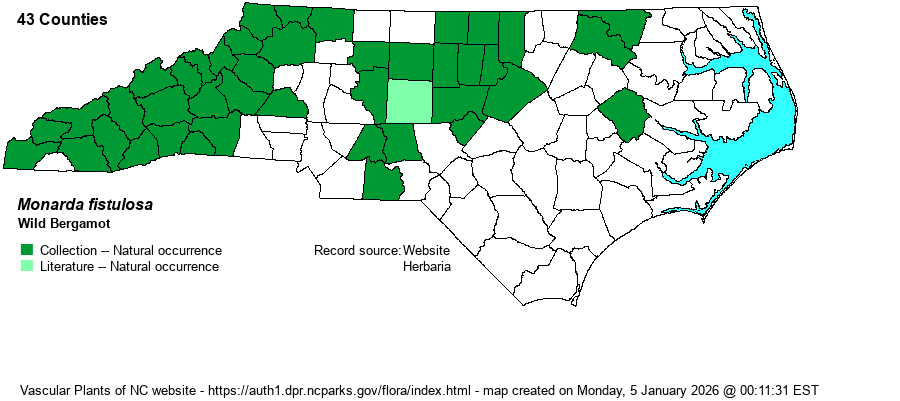| Author | L. | |
| Distribution | Throughout the Mountains; present over most of the Piedmont, but scarce to locally absent in some southern counties. Casual to Pitt County, in the Coastal Plain, if a natural occurrence there. As with all of the Monarda species, the iNaturalist website contains photos from many counties not shown on the map below; the editors tend to discard nearly all of these owing to frequency of planting of members of this genus in gardens and other places. | |
| Abundance | Frequent to common in the Mountains; infrequent to locally fairly common in the northern and central Piedmont, but very rare in the southern counties. Seems to have declined considerably in NC over the past 50 years, at least in the Piedmont; as this species prefers meadow habitats, many such habitats have been lost to development, abandonment, and other factors. | |
| Habitat | The nominate variety of the species favors fairly high pH soil, in dry to mesic and mostly sunny to only partly shaded habitats. It is most common in meadows, wooded borders, old fields, and openings in dry or upland forests. However, two of the varieties grow inside moist or rich forests. | |
| Phenology | Blooms from June to September, and fruits from August to October. | |
| Identification | This is a fairly tall Monarda, unbranched to partly branched, and averaging 3 feet tall. It has several pairs of opposite leaves, ovate to lanceolate like others in the genus, about 3-4 inches long and 1-inch wide, tapered to the tip but rounded to squared at the base, serrated on the margins, and with a short petiole. In this species, the flower cluster at the end of a stem or branch usually contains lavender to bright pink flowers (in two of the three varieties), each being about 1-1.2 inches long, with the characteristic narrow upper and lower lips, widely spread to have an open "mouth". About 15-20 bloom simultaneously, each facing outward from a central axis; in addition, the bracts below the cluster usually have a lavender tint. Though several other Monarda species grow in the mountains, this is the only one with bright pink (and quite fragrant) flowers, and the only one that grows primarily in full sun of meadows and upland wooded margins. To confuse matters, a rare variety (var. rubra) contains rich purple flowers, very similar to those of M. media; however, that species has wider leaves (averaging 1.5 inches) and about twice as long as wide, versus narrow leaves in var. rubra, which are about 1-inch wide and about 3 times as long as wide. There are a few additional characters that separate this rare and poorly known variety from M. media, which itself is not overly well known in NC. | |
| Taxonomic Comments | Weakley (2018) lists three varieties of the species in NC: the nominate one -- M. fistulosa var. fistulosa, var. mollis, and var. rubra. Weakley's (2018) range maps indicate that the first two are "common" in the Mountains and the Piedmont, with the latter occurring on "Moist wooded slopes" as opposed to meadows and edges for the former. He indicates that var. rubra, also of "Moist slope forests" but "rare" and only in the Mountains, is a problematic taxon, confusable with M. media. This website has not (yet) mapped the distributions of the three varieties, as the specimen labels are probably not detailed enough to do this -- i.e., most specimens are simply named to the full species.
| |
| Other Common Name(s) | None | |
| State Rank | S4 | |
| Global Rank | G5 | |
| State Status | | |
| US Status | | |
| USACE-agcp | FACU link |
| USACE-emp | UPL link |

